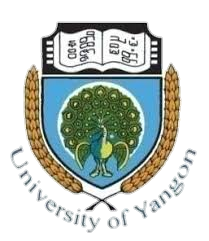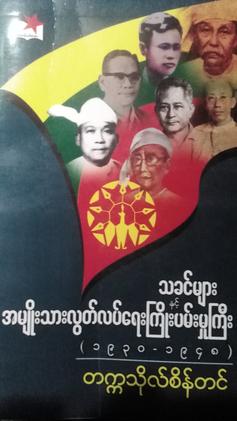
The Anti-Fascist People's Freedom League (AFPFL) was the dominant political alliance in Burma from 1945 to 1958. It consisted of political parties and mass and class organizations.

The University of Yangon, located in Kamayut, Yangon, is the oldest university in Myanmar's modern education system and the best known university in Myanmar. The university offers mainly undergraduate and postgraduate degrees programs in liberal arts, sciences and law. Full-time bachelor's degrees were not offered at the university's main campus after the student protests of 1996. The bachelor's degree was re-offered from 2014 on, to the best students in the country. Today degrees in Political Science are offered to undergraduate students, as well as postgraduate diplomas in areas such as social work and geology.

The president of the Republic of the Union of Myanmar is the head of state and constitutional head of government of Myanmar. The president chairs the National Defence and Security Council and normally leads the Cabinet of Myanmar, the executive branch of the Burmese government, though the prime minister leads the Cabinet under the current state of emergency. The current president is Myint Swe, who assumed the presidency in an acting capacity through a military coup d'état on 1 February 2021.

The Pyidaungsu Hluttaw is the de jure national-level bicameral legislature of Myanmar established by the 2008 National Constitution. The Pyidaungsu Hluttaw is made up of two houses, the Amyotha Hluttaw, a 224-seat upper house as well as the Pyithu Hluttaw, a 440-seat lower house.

General elections were held in Burma on 9 November 1932, having originally been planned for 29 October. The election was held almost solely on the issue of whether Burma should separate from India, as the British government had indicated that it would take the outcome of the elections as an indication of Burmese opinion. Prior to the elections many of the major parties joined either the Anti-Separation League or the Separation League.

Legislative Council elections were held in Burma on 21 November 1922, the first in the country's history.

Elections to the Legislative Council were held in Burma on 17 November 1925. Under the terms of the dyarchy constitution, the Legislative Council of Burma was advisory to the British colonial governor, and had some direct authority over education, local government, public health, agriculture and forests. The Nationalist Party received the most votes, but was unable to form a government as the British authorities favoured the Independent Party, who formed a government led by Joseph Augustus Maung Gyi.

Thakins and the Struggle for National Independence (1930–1948) is a book by Tekkatho Sein Tin, first published in 2009. This book includes biographies of several key leaders of Dobama Asiayone, a 1930s Burmese nationalist organization dedicated to overturn the British rule in Burma.

Kyaw Nyein, called honorifically U Kyaw Nyein, was a Burmese lawyer and anti-colonial revolutionary, a leader in Burma’s struggle for independence and prominent politician in the first decade after the country gained sovereignty from Britain. He held multiple minister portfolios in the government of Prime Minister U Nu, served as General Secretary of the ruling political alliance, Anti-Fascist People's Freedom League (AFPFL), and was joint General Secretary of the Burma Socialist Party (BSP).

The Independent Party, also known as the Golden Valley Party or, was a pro-British political party in Burma during the 1920s and 1930s. Its leadership included Joseph Augustus Maung Gyi, U Khin and U May Oung. Oscar de Glanville was also a party leader.

The 21 Party was a political party in Burma in the 1920s led by U Ba Pe.

The General Council of Burmese Associations (GCBA), also known as the Great Burma Organisation, was a political party in Burma.

The Anti-Separation League was a political alliance in Burma.

The United GCBA, also known as the Ngawbinwsaing, was a political party in Burma led by U Ba Pe.

The Hlaing-Myat-Paw GCBA was a political party in Burma led by Chit Hlaing.
Alinkar Kyawswa is the highest national honor of recognition of an individual for their artistic skills by the government of Myanmar. From 1949 to 2022, there were about 57 recipients of this award in Myanmar.
Sandayar Chit Swe was a Burmese singer-songwriter and pianist. He is best known for his songs such as "Chit Arr Nge Ya Thu Mal", "Kha Yay Pin Aut Ka Padauk Chit Thu'", "Chit Thu Way Way Thwar Par Nae Lar", "Nge Chit Haung Nae Hnit Paung Myar Swar" and "Yay Lo Aye Tae Nway Lay Ta Nway".
Thein Maung was a Burmese politician and a medical doctor. He was the first Burmese ambassador to Japan and was one of the 21-leader members of the YMBA and the GCBA.
Sir Paw Tun, also known as U Paw Tun, Maung Paw Tun, and Joseph Porter, was a Burmese administrator, barrister and politician who served as prime minister of British Burma in 1942, following the dismissal and arrest of U Saw until the evacuation of the Burmese government to India. A moderate nationalist and leading figure in pre-war Burmese politics, he was eventually displaced by the Anti-Fascist People's Freedom League, led by Aung San.









